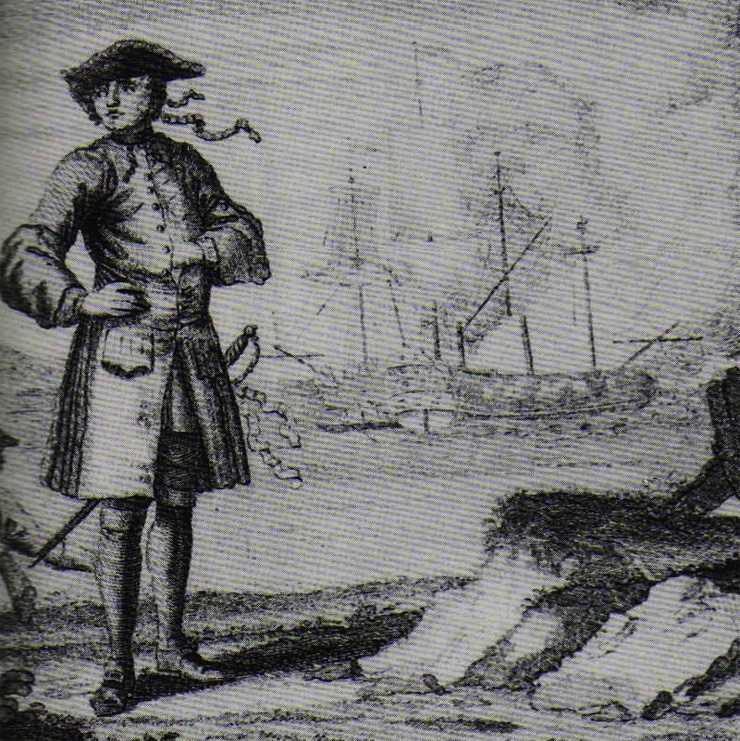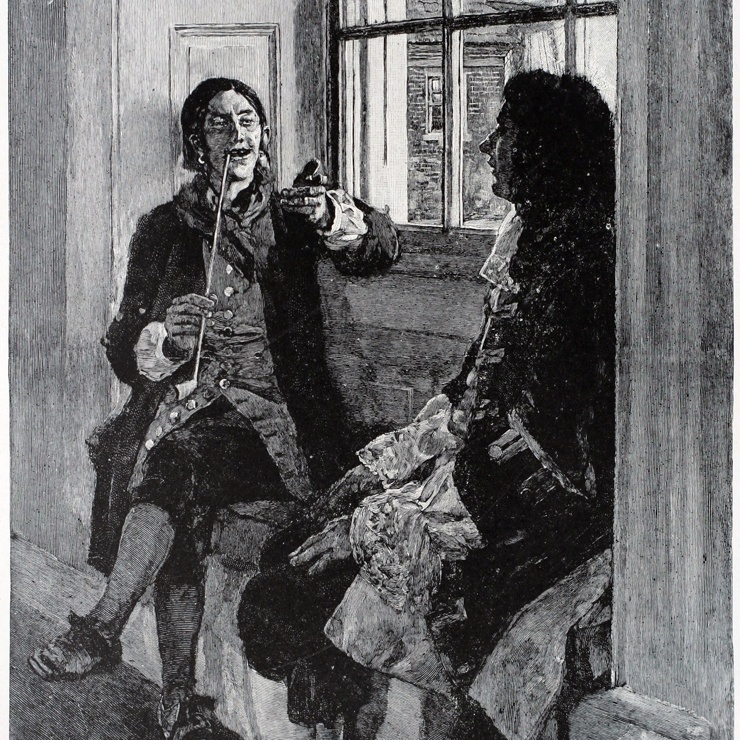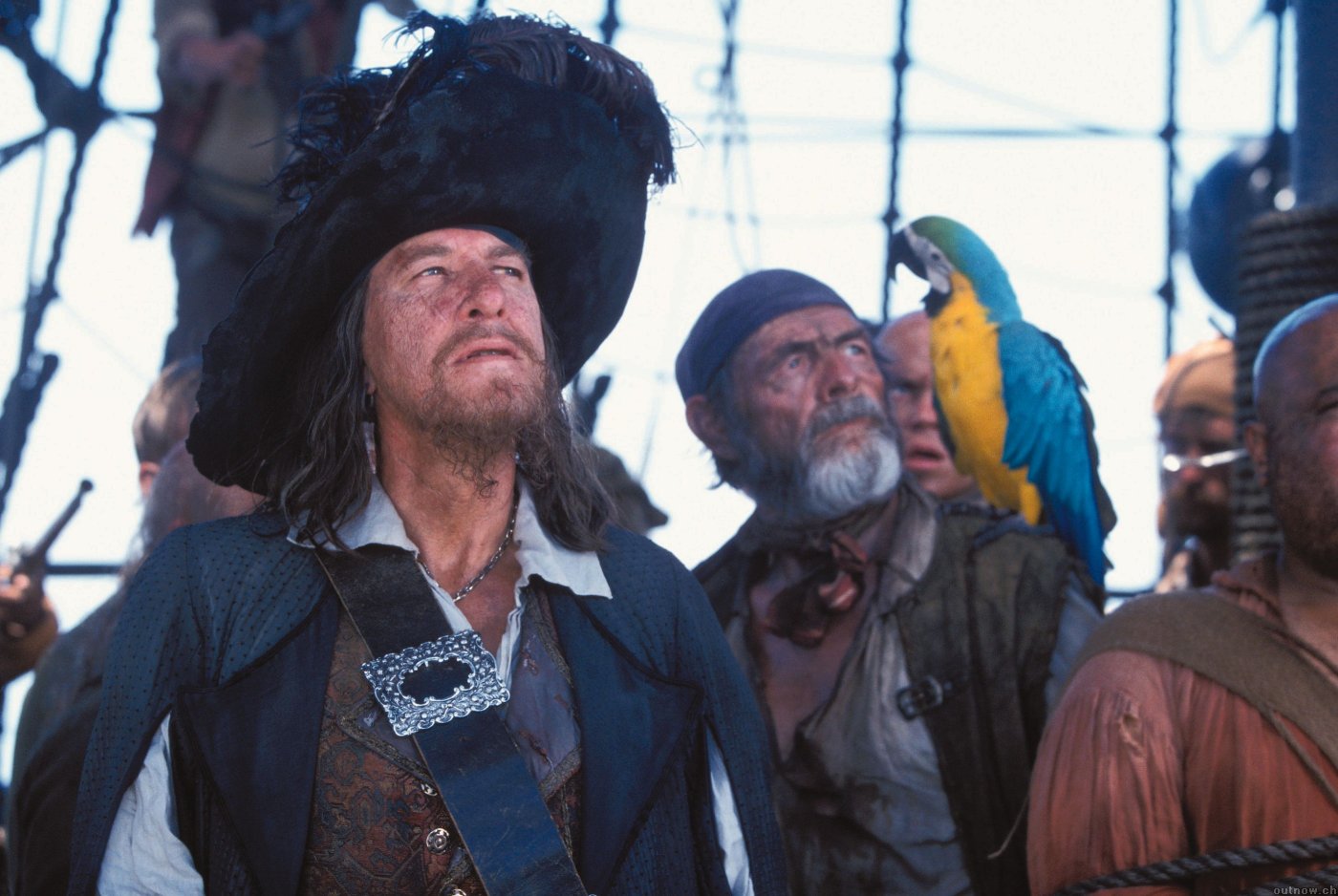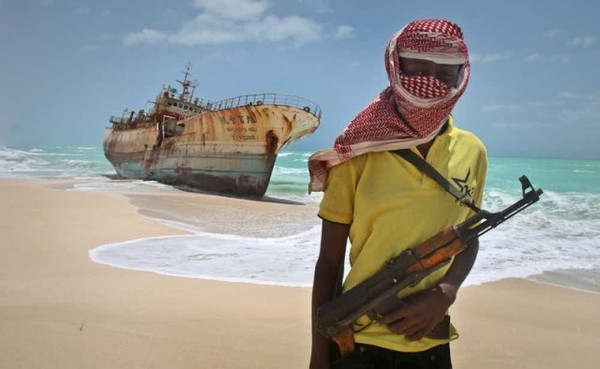The peak of sea robberies occurred in the 17th century, when the World Ocean was the arena of struggle between Spain, England and some other growing European colonial powers. Most often, pirates earned their living by independent criminal robberies, but some of them ended up in government service and deliberately harmed foreign fleets. Below is a list of the ten most famous pirates in history.
1. William Kidd

William Kidd (22 January 1645 – 23 May 1701) was a Scottish sailor who was convicted and executed for piracy after returning from a voyage to the Indian Ocean where he was supposed to hunt pirates. He is considered one of the most brutal and bloodthirsty sea robbers of the seventeenth century. The hero of many mysterious tales. Some modern historians, such as Sir Cornelius Neale Dalton, consider his pirate reputation unfair.
2. Bartholomew Roberts

Bartholomew Roberts (17 May 1682 – 17 February 1722) was a Welsh pirate who robbed about 200 ships (according to another version, 400 ships) in the vicinity of Barbados and Martinique in two and a half years. He is known primarily as the opposite of the traditional image of a pirate. He was always well dressed, had refined manners, hated drunkenness and gambling, and treated the crews of the ships he captured well. He was killed by cannon shot during a battle with a British warship.
3. Blackbeard

Blackbeard or Edward Teach (1680 – November 22, 1718) was an English pirate who operated in the Caribbean Sea from 1716 to 1718. He enjoyed instilling fear in his enemies. During battle, Teach would weave flaming fuses into his beard and, like Satan from hell, would rush into the enemy's ranks in clouds of smoke. Due to his unusual appearance and eccentric behavior, history has made him one of the most famous pirates, despite the fact that his "career" was quite short, and his success and scale of activity were much smaller than his other colleagues on this list.
4. Jack Rackham

Jack Rackham (December 21, 1682 – November 17, 1720) was an English pirate who became famous primarily because his crew included two equally famous corsairs, the female pirates Anne Bonny, nicknamed "Mistress of the Seas", and Mary Read.
5. Charles Vane

Charles Vane (1680 – March 29, 1721) was an English pirate who robbed ships between 1716 and 1721 in North American waters. He was famous for his extreme cruelty. As history tells us, Vane did not indulge in such feelings as compassion, pity and sympathy, he easily broke his own promises, did not respect other pirates and did not take into account anyone's opinion at all. The meaning of his life was only prey.
6. Edward England

Edward England (1685 – 1721) was a pirate who operated off the coast of Africa and in the Indian Ocean from 1717 to 1720. He differed from other pirates of the time in that he did not kill prisoners unless absolutely necessary. This eventually led to his crew mutiny when he refused to kill sailors from another captured English merchant ship. England was subsequently marooned in Madagascar, where he survived for some time by begging, and eventually died.
7. Samuel Bellamy

Samuel Bellamy, nicknamed Black Sam (23 February 1689 – 26 April 1717) was a great English sailor and pirate who operated in the early 18th century. Although his career lasted little more than a year, he and his crew captured at least 53 ships, making Black Sam the richest pirate in history. Bellamy was also known for his mercy and generosity towards those he captured in his raids.
8. Saida al-Hurra

Sayyida al-Hurra (1485 – c. July 14, 1561) was the last queen of Tetouan, Morocco, who reigned between 1512–1542, and was a pirate. In alliance with the Ottoman corsair Aruj Barbarossa of Algiers, al-Hurra controlled the Mediterranean Sea. She became famous for her fight against the Portuguese. She is considered one of the most outstanding women in the Islamic West in the modern era. The date and exact circumstances of her death are unknown.
9. Thomas Tew

Thomas Tew (1649 – September 1695) was an English privateer and pirate who made only two major piratical voyages, a route later known as the "Pirate Round". He was killed in 1695 while attempting to rob the Mughal ship Fateh Muhammad.
10. Stede Bonnet

Stede Bonnet (1688 – December 10, 1718) was a prominent English pirate, nicknamed the "pirate gentleman". Interestingly, before Bonnet turned to piracy, he was quite a wealthy, educated and respected man, owning a plantation in Barbados.
11. Madame Shi

Madame Shi, or Madame Zheng, is one of the most famous female pirates in the world. After her husband's death, she inherited his pirate fleet and put sea robbery on a grand scale. She commanded two thousand ships and seventy thousand people. She was able to command an entire army thanks to the strictest discipline. For example, for unauthorized absence from the ship, the offender would lose an ear. Not all of Madame Shi's subordinates were happy with this state of affairs, and one of the captains once rebelled and went over to the side of the authorities. After Madame Shi's power was weakened, she agreed to a truce with the emperor and subsequently lived to a ripe old age in freedom, running a brothel.
12. Francis Drake

Francis Drake is one of the most famous pirates in the world. Actually, he was not a pirate, but a corsair, who operated on the seas and oceans against enemy ships with a special permit from Queen Elizabeth. Devastating the coasts of Central and South America, he became incredibly rich. Drake accomplished many great deeds: he discovered a strait, which he named in his honor, and under his command the British fleet defeated the Great Armada. Since then, one of the ships of the English navy bears the name of the famous navigator and corsair Francis Drake.
13. Henry Morgan

The list of the most famous pirates would be incomplete without the name of Henry Morgan. Despite the fact that he was born into a wealthy family of an English landowner, Morgan linked his life with the sea from his youth. He hired himself out as a cabin boy on one of the ships and was soon sold into slavery in Barbados. He managed to get to Jamaica, where Morgan joined a gang of pirates. Several successful voyages allowed him and his comrades to buy a ship. Morgan was chosen as a captain, and this was a good decision. A few years later, he had 35 ships under his command. With such a fleet, he managed to capture Panama in one day and burn the entire city. Since Morgan acted mainly against Spanish ships and pursued an active English colonial policy, the pirate was not executed after his arrest. On the contrary, for the services he rendered to Britain in the fight against Spain, Henry Morgan received the post of vice-governor of Jamaica. The famous corsair died at the age of 53 from cirrhosis of the liver.
14. Edward Teach

Edward Teach, or Blackbeard, is one of the most famous pirates in the world. Almost everyone has heard his name. Teach lived and engaged in sea robbery during the heyday of the golden age of piracy. Having entered the service at the age of 12, he gained valuable experience, which later came in handy in the future. According to historians, Teach participated in the War of the Spanish Succession, and after its end, he consciously decided to become a pirate. The glory of a ruthless filibuster helped Blackbeard to capture ships without using weapons - upon seeing his flag, the victim surrendered without a fight. The fun life of a pirate did not last long - Teach died during a boarding battle with a British warship pursuing him.
15. Henry Avery

One of the most famous pirates in history is Henry Avery, nicknamed Long Ben. The father of the future famous buccaneer was a captain in the British navy. Avery dreamed of sea voyages since childhood. He began his career in the navy as a cabin boy. Then Avery was appointed first mate on a corsair frigate. The ship's crew soon rebelled, and the first mate was proclaimed captain of the pirate vessel. So Avery took the path of piracy. He became famous for capturing the ships of Indian pilgrims heading to Mecca. The pirates' booty was unheard of for those times: 600 thousand pounds and the daughter of the Great Mogul, whom Avery later officially married. How the life of the famous filibuster ended is unknown.
16. Amaro Pargo

Amaro Pargo is one of the most famous filibusters of the golden age of piracy. Pargo was a slave transporter and made a fortune from it. His wealth allowed him to do charity work. He lived to a ripe old age.
17. Aruj Barbarossa

A famous powerful pirate from Turkey. He was characterized by cruelty, ruthlessness, love of mockery and executions. He was engaged in piracy together with his brother Khair. The Barbarossa pirates were the terror of the entire Mediterranean. Thus, in 1515, the entire Azier coast was under the rule of Aruj Barbarossa. The battles under his command were sophisticated, bloody and victorious. Aruj Barbarossa died during the battle, surrounded by enemy troops in Tlemcen.
18. William Dampier

A navigator from England. He was an explorer and discoverer by vocation. He made 3 round-the-world voyages. He became a pirate in order to have the means to carry out his research activities - studying the direction of winds and currents in the ocean. William Dampier is the author of such books as "Travels and Descriptions", "A New Voyage Around the World", "The Direction of the Winds". An archipelago in the northwest coast of Australia is named after him, as well as a strait between the west coast of New Guinea and the island of Waigeo.
19. Grace O'Mail

A female pirate, a legendary captain, a lady of fortune. Her life was full of colorful adventures. Grace possessed heroic courage, unprecedented determination and a high talent for piracy. For her enemies she was a nightmare, for her supporters an object of admiration. Despite the fact that she had three children from her first marriage and one child from her second, Grace O'Mail continued her favorite business. Her activities were so successful that Queen Elizabeth I herself offered Grace to serve her, to which she received a decisive refusal.
20 . Anne Bonny

Anne Bonny, one of the few women who succeeded in piracy, grew up in a wealthy mansion and received a good education. However, when her father decided to marry her off, she ran away from home with a simple sailor. After some time, Anne Bonny met the pirate Jack Rackham, and he took her on his ship. According to eyewitnesses, Bonny was as brave and skilled in fighting as male pirates.
Incredible Facts About Pirates
1. In the 18th century, the Bahamas were a haven for pirates.

The Bahamas, today a respectable resort, and its capital, Nassau, were once the capital of maritime lawlessness. In the 17th century, the Bahamas, formally belonging to the British Crown, had no governor, and the reins of government were taken over by pirates. At that time, more than a thousand sea robbers lived in the Bahamas, and the most famous pirate captains moored in the island's harbors. The pirates preferred to call Nassau Charlestown in their own way. Peace returned to the Bahamas only in 1718, when British troops landed in the Bahamas and regained control of Nassau.
2. The Jolly Roger is not a single pirate flag.

The Jolly Roger, a black flag with a skull and crossbones, is often called the main pirate symbol. But this is not entirely true. Rather, it is the most famous and spectacular. However, it was not used as often as is commonly believed. It appeared as a pirate flag only in the 17th century, that is, at the end of the golden era of piracy. And not all pirates used it, since each captain decided for himself which flag to use for his raids. So, along with the Jolly Roger, there were dozens of pirate flags, and the skull and crossbones was not particularly popular among them.
3. Why did pirates wear earrings?

Books and movies don't lie: pirates almost universally wore earrings. They were even part of a pirate initiation ritual: young pirates received an earring upon their first crossing of the equator or Cape Horn. The fact is that there was a belief among pirates that an earring in the ear helps preserve vision and even helps cure blindness. It was this pirate superstition that led to the widespread fashion for earrings among sea robbers. Some even tried to use them for a dual purpose, casting a spell on the earring to prevent drowning. Also, an earring taken from the ear of a dead pirate could guarantee the deceased a decent burial.
4. There were many female pirates

Oddly enough, women in pirate crews were not such a rare phenomenon. There were even quite a few female captains. The most famous of them are the Chinese Cheng Yi Sao, Mary Read and, of course, the famous Anne Bonny. Anne was born into a family of a wealthy Irish lawyer. Her parents dressed her as a boy from an early age so that she could help her father in the office as a clerk. The boring life of a lawyer's assistant did not appeal to Anne, and she ran away from home, joining the pirates and quickly becoming a captain thanks to her determination. According to rumors, Anne Bonny had a hot temper and often beat her assistants if they tried to challenge her opinion.
5. Why are there so many one-eyed pirates?

Anyone who has watched a movie about pirates has probably wondered at least once: why are there so many one-eyed people among them? An eye patch has long been an essential part of the pirate image. However, pirates did not wear it because they were all missing an eye. It was simply convenient for quick and more accurate aiming in battle, and putting it on for battle took too long - it was more comfortable to wear it without taking it off.
6. There was strict discipline on pirate ships.

Pirates could commit any kind of mischief on the shore, but strict discipline reigned on board pirate ships - after all, the lives of sea robbers depended on it. Each pirate, joining the ship, signed a contract with the captain, stipulating his rights and obligations. The main obligations were unquestioning obedience to the captain. A simple pirate did not even have the right to directly address the commander. Only an appointed representative of the team - usually the boatswain - could do this at the insistence of the sailors. In addition, the contract strictly defined the share of the booty that the pirate received, and an attempt to hide the captured goods was punishable by immediate execution - this was done to avoid bloody showdowns on board.
7. Among the pirates there were representatives of all walks of life.

Among the sea robbers there were not only the poor who went to sea for lack of other means of subsistence, or fugitive criminals who did not know the possibility of earning money legally. Among them there were also people from rich and even noble families. For example, the famous pirate William Kidd - Captain Kidd - was the son of a Scottish nobleman. Initially, he was an officer of the British Navy and a pirate hunter. But his innate cruelty and passion for adventure pushed him to another path. In 1698, under cover of the French flag, Kidd captured a British merchant ship loaded with gold and silver. When the first prize turned out to be so impressive - could Kidd refuse to continue his career?
8. Buried pirate treasures are legends

There are many legends about buried pirate treasures, many more than the treasures themselves. Of all the famous pirates, only one is known to have buried treasures: William Kidd, hoping to use them as ransom if he was caught. It didn't help him: after his capture, he was immediately executed as a pirate. Usually, pirates did not leave behind large fortunes. Pirates' expenses were high, their crews were numerous, and each member of the crew, including the captain, was succeeded by one of his friends and colleagues. At the same time, realizing that their life was short, pirates preferred to throw money around rather than hide it in view of a very unreliable future.
9. Walking along the yardarm was a rare punishment

According to the movies, the most common method of execution among pirates was the "yardarm walk," when a person with his hands tied was forced to walk along a thin yardarm until he fell overboard and drowned. In reality, this punishment was rare and was only used on sworn personal enemies - to see their fear or panic. The traditional punishment was the "keel drag," when a pirate or obstinate prisoner punished for disobedience was lowered overboard with ropes and dragged under the bottom of the ship, pulling out on the other side. A good swimmer could easily avoid drowning during the punishment, but the body of the punished person was so cut up by barnacles clinging to the bottom that recovery took many weeks. The punished person could easily die, and, again, more likely from wounds than from drowning.
10. Pirates sailed all the seas

After the movie "Pirates of the Caribbean" many people believe that the nest of world piracy was the seas of Central America. In fact, piracy was equally widespread in all regions - from Britain, whose privateers, pirates in the service of the king, brought terror to European ships, to Southeast Asia, where piracy remained a real force until the 20th century. And the raids of the northern peoples on the cities of Ancient Rus' along the rivers were real pirate raids!
11. Piracy as a way to make a living

In hard times, many hunters, shepherds and lumberjacks went into piracy not for adventure, but for a simple piece of bread. This was especially true for residents of Central American countries, where in the 17th-18th centuries there was an endless battle between European powers for colonies. Constant armed clashes deprived people not only of work, but also of their homes, and residents of coastal settlements had known seamanship since childhood. So they went where they had a chance to be well-fed and not think too much about tomorrow.
12. Not all pirates were outlaws.

State piracy is a phenomenon that has existed since ancient times. Barbary corsairs served the Ottoman Empire, Dunkerque privateers served Spain, and Britain, in the era of ocean dominion, maintained a fleet of privateers—warships that captured enemy merchant ships—and corsairs—private individuals engaged in the same trade. Although state pirates engaged in the same trade as their free brethren, the difference in their status was enormous. Captured pirates were subject to immediate execution, while a corsair with a corresponding patent could count on the status of a prisoner of war, a quick ransom, and a state reward—like Henry Morgan, who received the post of governor of Jamaica for his corsair service.
13. Pirates still exist today

Today's pirates are armed with modern machine guns instead of cutlasses, and they prefer modern speedboats to sailing vessels. However, they act just as decisively and ruthlessly as their ancient predecessors. The Gulf of Aden, the Strait of Malacca and the coastal waters of Madagascar are considered the most dangerous places in terms of pirate attacks, and civilian ships are advised not to enter them without an armed escort.
7 Scariest Pirates in History
With the advent of the famous Jack Sparrow, pirates have become the cartoon characters of modern pop culture. And so it is easy to forget that real sea robbers were more formidable than their Hollywood parody. They were brutal mass murderers and slave owners. In a word, they were pirates. Real pirates, not pathetic caricatures. As evidenced by the following…
1. Francois Olonnet

French pirate François Ohlone hated Spain with all his heart. Early in his piratical career, Ohlone nearly died at the hands of Spanish marauders, but instead of reconsidering his life and becoming, say, a farmer, he decided to dedicate himself to hunting the Spanish. He made his feelings about this people clear after he beheaded the entire crew of a Spanish ship he came across except for one man, who sent the following words to his fellow pirates: “From this day forward, no Spaniard will receive a cent from me.”
But that was just the tip of the iceberg. Considering what happened next, it can be said that the beheaded Spaniards got off easy.
Having earned a reputation as a cutthroat, Ohlone gathered eight pirate ships and several hundred men under his command and set out to terrorize the coast of South America, destroying Spanish cities, capturing ships heading to Spain, and generally causing a major headache for that nation.
However, Olona's luck suddenly turned against him when he was ambushed by outnumbered Spanish soldiers while returning from yet another raid on the Venezuelan coast. Explosions thundered here and there, pirates were blown to pieces, and Olona barely managed to escape from this meat grinder, capturing several hostages along the way. But that was not the end of his difficulties, for Olona and his crew still had to leave enemy territory alive and not run into another ambush, which they simply would not be able to fight off.
What did Olone do? He took out his sabre, slashed one of the Spanish hostages across the chest, pulled out his heart and "bite into it with his teeth like a greedy wolf, saying to the others: 'The same will happen to you if you don't show me the way out.'"
The intimidation worked, and soon the pirates were out of danger. And if you're wondering what happened to the heads of the decapitated Spaniards we mentioned earlier... well, let's just say that for a week the pirates ate like kings.
2. Jean Lafitte

Despite his effeminate name and French origins, Jean Lafitte was a true pirate king. He owned his own island in Louisiana, plundered ships, and smuggled the stolen goods to New Orleans. Lafitte was so successful that when the governor of Louisiana offered $1,000 for his capture (at the time, $300 was half the country's budget), the pirate countered with $1,000 for the governor himself.
Lafitte was painted by newspapers and authorities as a dangerous, brutal criminal and mass murderer, an 1800s Osama bin Laden, if you will. Apparently, his fame crossed the Atlantic, because in 1814, Lafitte received a letter personally signed by King George III, offering the pirate British citizenship and land if he would side with them. He also promised not to destroy his little island and sell it off piece by piece. Lafitte asked for a few days to think about it… and in the meantime, he rushed straight to New Orleans to warn the Americans of the British advance.
So, the United States may not have liked Jean Lafitte, but Lafitte felt the United States was like family.
Although he was not an American, Lafitte treated the new country with respect and even ordered his fleet not to attack American ships. Lafitte personally killed one pirate who disobeyed his order. The privateer also treated hostages well and sometimes returned their ships if they were not suitable for pirating. The people of New Orleans considered Lafitte almost a hero, since the contraband he brought back allowed people to buy things they could not otherwise afford.
So how did the American authorities react to the news of the coming British attack? They attacked Lafitte's island and captured his men, because they thought he was simply lying. Only after future President Andrew Jackson intervened, noting that New Orleans was not prepared to withstand a British attack, did the authorities agree to release Lafitte's men on the condition that they agree to help their navy.
It can be said that it was only thanks to the pirates that the Americans managed to defend New Orleans, which otherwise could have been a significant strategic victory for the British. In this city, the latter could gather their forces before attacking the rest of the country. Just think: if it were not for this unwashed French "terrorist", the United States might not exist today.
3. Stephen Decatur

Stephen Decatur doesn't fit the typical pirate mold in that he was a fairly respected officer in the U.S. Navy. Decatur became the youngest captain in the history of the Navy, which would be a ridiculous fiction if it weren't true. He was considered a national hero, and for a time, his portrait even appeared on the twenty-dollar bill.
How did he achieve such popularity? By organizing some of the most epic and bloody raids in history.
For example, when Tripolitan pirates captured the frigate Philadelphia in 1803, 25-year-old Decatur gathered a group of men dressed as Maltese sailors and armed only with swords and pikes, and entered the enemy harbor. There, without losing a single man, he captured the enemy and set fire to the frigate so that the pirates could not use it. Admiral Horatio Nelson called the raid "the boldest and most daring adventure of the century."
But that's not all. Later, returning from capturing another vessel with a crew twice the size of Decatur's, he learned that his brother had been mortally wounded in a fight with pirates. Despite his crew being exhausted from the recent raid, Decatur turned the ship around and pursued the enemy ship, which he and ten others later boarded.
Ignoring the others, Decatur ran straight to the man who had shot his brother and killed him. The rest of the crew eventually surrendered. Thus, in one day, the young man had captured 27 hostages and killed 33 pirates.
He was only 25 years old.
4. Ben Hornigold

Benjamin Hornigold was Blackbeard's Emperor Palpatine. While his protégé became the most famous pirate in history, Hornigold was forever relegated to the footnote of Edward Titch.
Hornigold began his pirate career in the Bahamas, with only a couple of small boats at his disposal. However, after a few years, Hornigold was sailing on a huge 30-gun warship, which made his sea piracy much easier. So much so that, apparently, the privateer began to rob purely for fun.
Once, for example, in Honduras, Hornigold boarded a merchant ship, but all he demanded from the crew was their hats. He explained his demand by saying that the previous night his crew had gotten very drunk and lost their hats. Having received what he wanted, Hornigold boarded his ship and sailed away, leaving the merchants with their goods.
And this was not the only case. On another occasion, a crew of sailors captured by Hornigold reported that the pirate let them go with only "a little rum, sugar, gunpowder and ammunition."
Unfortunately, his crew did not seem to share their captain's views. Hornigold always considered himself a "privateer" rather than a pirate, and to prove it, he refused to attack British ships. This stance did not find favor with the sailors, and Hornigold was eventually deposed, with a good portion of his crew and ships going over to Blackbeard. Before he lost his head.
Hornigold, however, abandoned his pirate life, accepted the king's pardon, and switched sides, hunting down those he had once associated with.
5. William Dampier

Englishman William Dampier was used to achieving a lot. Not wanting to be satisfied with the status of the first person to circumnavigate the globe three times, as well as a recognized author and research scientist, he had a small business on the side - he robbed Spanish settlements and plundered other people's ships. All this in the name of science, of course.
Pop culture would have us believe that pirates were all toothless, illiterate bums, but Dampier was the opposite: he not only respected the English language, he also filled it with new words. The Oxford English Dictionary cites Dampier over a thousand times in its entries, as he is credited with spellings of words like "barbecue," "avocado," "chopsticks," and hundreds of others.
Dampier was recognized as Australia's first naturalist, and his contribution to Western culture was invaluable. It was his observations that Darwin based his theory of evolution on, and he is also mentioned in praise in Gulliver's Travels.
His most notable achievement, however, was not literary or scientific. In 1688, with his first circumnavigation nearly complete, Dampier sent his crew packing and landed somewhere on the coast of Thailand. There he boarded a canoe and rowed home. Dampier did not reach English shores until three years later, with nothing on him but a journal… and a tattooed slave.
After this, he published his first book, which became a huge success.
6. Black Bart

In the 17th and 18th centuries, sailing on military or merchant ships was an extremely thankless job. The working conditions were disgusting, and if you suddenly angered a superior, the punishment that followed was extremely cruel and often resulted in death. As a result, no one wanted to become a sailor, so the military and merchants had to literally kidnap people from ports and force them to work on their ships. It is clear that this method of hiring did not awaken in the sailors any particular loyalty to the cause and their superiors.
Bartholomew Roberts (or simply "Black Bart") became a pirate by force, which, however, does not make him worse than others. Roberts worked on a slaver's ship, which was captured by pirates. When they invited sailors to join them, he agreed without thinking twice. Although it is possible that the robbers also threatened to kill him if he did not go with them. Thanks to his high intelligence and talent for navigation, Roberts quickly won the trust of the captain. When the latter was killed, he (who by that time had lived with the pirates for only six months) was elected to take his place.
Roberts became a distinguished pirate, but apparently never forgot where he came from. When he boarded a ship, he would ask the captured sailors if the captain and officers had treated them well before he made his living. If a complaint was filed against any of the commanding officers, Roberts would deal with the offenders mercilessly. Incidentally, this was a practice practiced by other pirates, although their punishments were more sophisticated.
Roberts, being a civilized man, eventually forced his crew (the same ones who had captured him earlier) to follow a strict code of conduct consisting of 11 points, among which were: no gambling, no women on board, lights out at 8 p.m., and mandatory washing of soiled bed linen.
7. Barbarossa

In movies and TV shows, a pirate can be considered lucky if they have at least one ship and a crew of a couple dozen people. But as it turns out, some real pirates were much luckier in life. For example, the Turkish pirate Hayreddin Barbarossa not only had his own fleet, but also his own state.
Barbarossa started out as a simple merchant, but after a bad political decision (he supported the wrong candidate for sultan), he was forced to leave the Eastern Mediterranean. Becoming a pirate, Barbarossa began attacking Christian ships in the area of today's Tunisia until his enemies captured his base, leaving him homeless. Tired of being constantly thrown out, Barbarossa founded his own state, known as the Regency of Algiers (the territory of today's Algeria, Tunisia and part of Morocco). He succeeded thanks to an alliance with the Turkish sultan, who supplied him with ships and weapons in exchange for support.
How high did this guy get, you ask? Let's put it this way: Barbarossa once single-handedly defeated the combined forces of Venice, the Vatican, Genoa, Spain, Portugal and Malta at the Battle of Preveza (1538). He had 122 ships under his personal command at the time.












